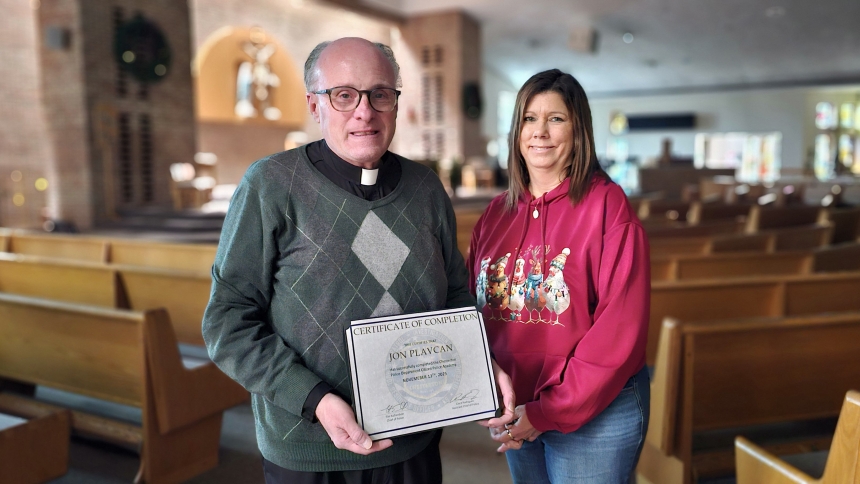
Filipino novena Mass celebrated at cathedral as a lively Advent tradition
GARY – On Dec. 19, an ethnic group that sees their Advent less as a subdued time of waiting for the arrival of the Christ Child, and more of a celebration of certainty in anticipation of the birth of Jesus, filled the Cathedral of the Holy Angels with prayer and praise.
The Simbang Gabi Mass, Filipino for "Night Mass” (or before dawn), was hosted at 11 a.m. Some described it as an “easy” or “comfortable” time for the faithful to gather. In the Philippines, the pre-Christmas novena Masses dating back to the Spanish colonial period, typically have Catholics waking to celebrate Mass at 5 a.m. or earlier.
“This was like a regular Mass time, but we made ourselves think of this as an early morning Mass," said Mindy Carlay, of St. Michael the Archangel in Schererville.
Carlay and other cathedral visitors said they already had breakfast, unlike how it would have transpired in their native country.
“When people ask why we are doing this, we (explain) this is our tradition in the Philippines, as Catholics,” Carlay said.
In the 1600s, Spanish clergy discovered a workaround to the fatigue the mainly agrarian natives suffered and began to offer liturgies in the pre-dawn hours before the laborers began their work.
The tradition of the Simbang Gabi novena remains a popular and colorful celebration in Asia’s only predominantly Catholic country. Last year marked the 500th anniversary of the introduction of Christianity by Spanish missionaries to the archipelagic country in Southeast Asia.
Diocesan faithful of Filipino heritage, as well as other visitors to the Sunday Mass, heard songs not like the anticipatory Western-style “O Come, O Come Emmanuel” or “My Soul in Stillness Waits”, but rather hymns of celebration.
“Himig ng Pasko’s” was one hymn sung with great volume by performers and musicians of the Asian Ministry Choir, including teenage cantor Chaela Laus, of St. Edward in Lowell.
Its first two verses translated from the Filipino native Tagalog to English are:
“The blowing wind is cold/Every feeling is so joyful/The beating of the heart in the chest/Is like a gift from heaven.
“The sound of Christmas is all over/Everyone has vitality/There’s no sadness/The joy is perfect.”
The Asian-American musicians performed under a large, illuminated light styled like a star. Traditionally, these homemade lights, or paról, were used by travelers to help them make their way to churches in the pre-dawn hours.
During his homily presider Bishop Robert J. McClory spoke of how the celebration enriches the greater Catholic family.
“It’s a reminder of the richness that many of our cultures bring to our Christmas celebration," the bishop said. “And, it’s a great tribute to the intensity, the fervor, which our Filipino brothers and sisters enter into this season.
He continued, “That intensity says my identity, all that I have, all that gives me meaning, is my relationship with Jesus Christ, and placing him first is what’s important.”
Lynn Tabion, wife of Deacon Napoleon Tabion of St. Thomas More in Munster, who assisted Bishop McClory at the Simbang Gabi Mass, recalled her experiences preparing for the novenas in her native Philippines. The church of Lynn Tabion’s youth was Holy Family in Quezon City.
“We woke up at about 3 (a.m.) to attend the 4 (a.m.) Mass," said Lynn Tabion. “And when I was growing up it was in Latin – the high Mass – but now it has been changed into our vernacular, Tagalog.
She added, “We look forward to this. This is the highlight of our Christmas, which is also a family celebration.”
In the Philippines, vendors line the streets outside parishes and churchgoers purchase snacks, such as bibingka, or rice pastries, when the Masses have concluded.
Many of those who attended Simbang Gabi are members of the Northwest Indiana-based Philippine Professional Association. From various professions, they gathered after Mass in the cathedral narthex for some traditional Filipino snacks and classic American lunch sandwiches.
Danny Sardon, of Notre Dame parish in Michigan City, said he didn’t mind walking for miles in the early morning to get to church when he was a child and young man. “This is a celebration for the coming of Jesus.”
“We do it from the 14th to 24th of December. The culmination is the Noche Bueno, when it comes to the food,” Sardon said, referring to what is Christmas Eve in the Spanish-speaking world.
Sardon added, “Unfortunately, right now you can’t smell the food because it is simple sandwiches (in the narthex), but if you were in a (traditional Simbang Gabi) you could smell the aroma before you got there.”
Though the cold Midwestern winter was not conducive to parades or outdoor fairs and the cathedral exterior was not trimmed with bright strings of lights, a bit of the warmth of the Filipino Advent and Christmas tradition was brought together.
“I think we are trying to maintain this tradition, that’s why we are telling the younger generation," Carlay said. “We’ve taught our kids and brought them to (these gatherings) for many years. My grandchildren look forward to these traditions every year.”


